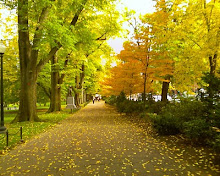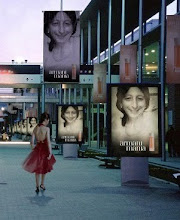
Christmas afforded me a change for another ever-so-brief return to my home town, New York City. So I am taking a little liberty with this post of urban vists about 230 miles from Boston.
On Christmas day, between opening presents and supper, we had a chance to stroll along
Riverside Drive and
Riverside Park. Located on the upper west side of Manhattan Island, this area has more in common topographically with Beverly Hill than the rest of the flat urban plate on which the famous skyscrapers are built. Here, there are steep hills, revines, and sudden drop-offs. But the urban fabric is pure NYC; no mistaking that!
Here, we start with some views up and down river along the mighty Hudson, which ebbs and flows along the west side of the isle of Manhattan. I was a cold and overcast day, and views are dreary, but none the less, spectacular. As a engineer, I was fascinated by the
Riverside Drive viaduct which carries this parkway near 100 feet (30 m) high above the city streets. Built in 1900, with gracefull, repeating arches, the structure possesses an eligance missing in most present-day engineers roadway bridges.
Walking through Riverside Park had the feel of Central Park, if it were streatched out, made much hiller and relocated to the banks of the Hudson. I could tell in the texture of the park, the lanscape vocabulary of park lamps, benches, and railings, there the hand of
Fredrick Law Olmsted was present. Olmsted was the landscape architect for NYC's Central Park and the Emerald Necklace in Boston.
One innovative idea, not noticed by most park goers, is that a rail line runs under the park in a tunnel. Thus, the park is partly built on what we now call air rights. This line, formerly New York Central's West Side Line (the north end of the now famous
High Line), now feeds Amtrak intercity trains from upstate New York to Penn Station.
Below Left: View downriver, with the tower of Riverside Church high about the waters of the Hudson.
Below Right: View upriver, with the George Washington Bridge visible

 Left: Close-up of Riverside Church
Left: Close-up of Riverside Church
Below: Riverside Drive runs high above Manhattan Valley near West 125th Street on a great steel viaduct.


Below: The hand of Olmsted is clear in the elements of Riverside Park, from the stone arches to the lampposts and railings, all reflective of his work in Centeral Park.

 As a transportation engineer, I have always been fascinated by railroads, particularly as they fit into urban and rural landscapes. Compared to modern highways, rail lines are much narrower and therefore were built less intrusively.
As a transportation engineer, I have always been fascinated by railroads, particularly as they fit into urban and rural landscapes. Compared to modern highways, rail lines are much narrower and therefore were built less intrusively.





















